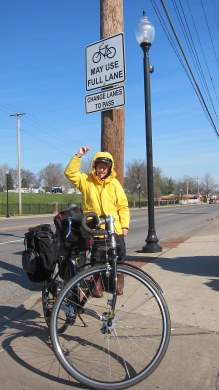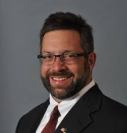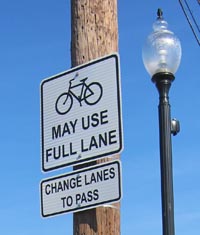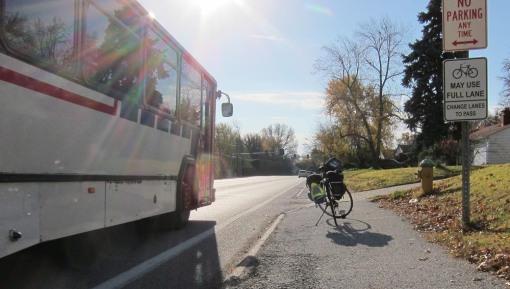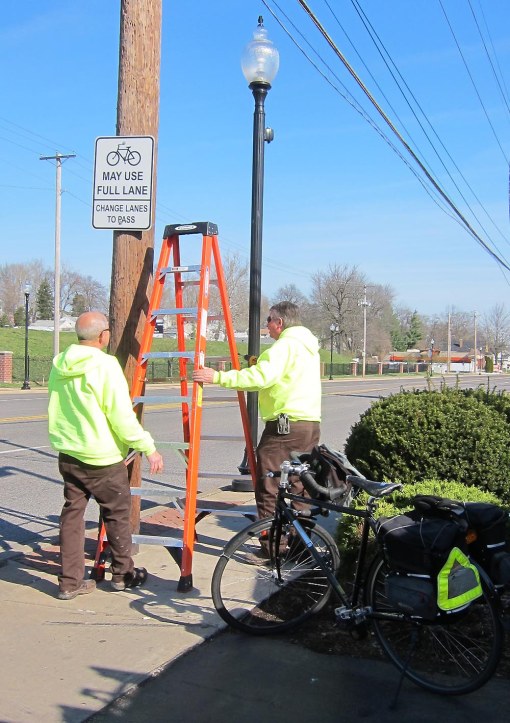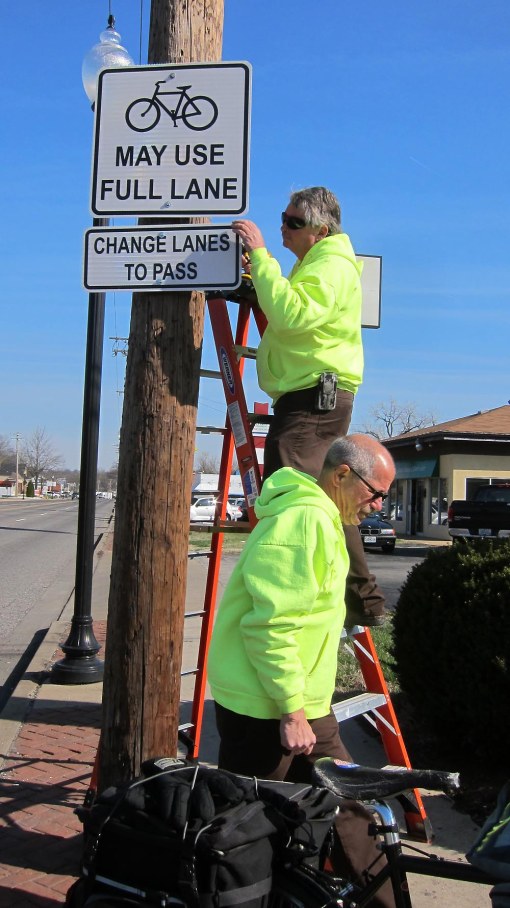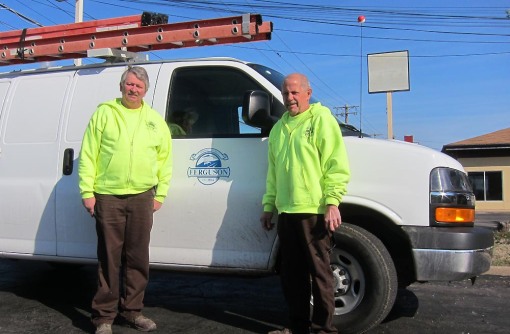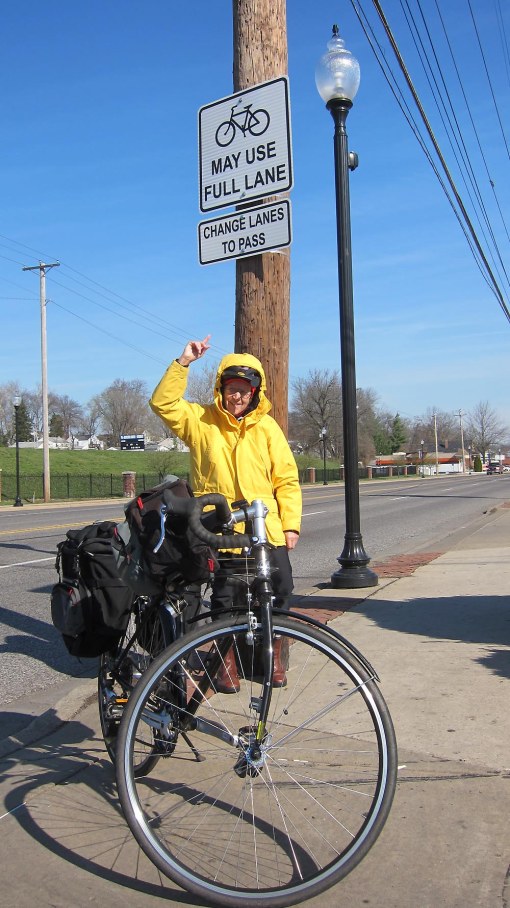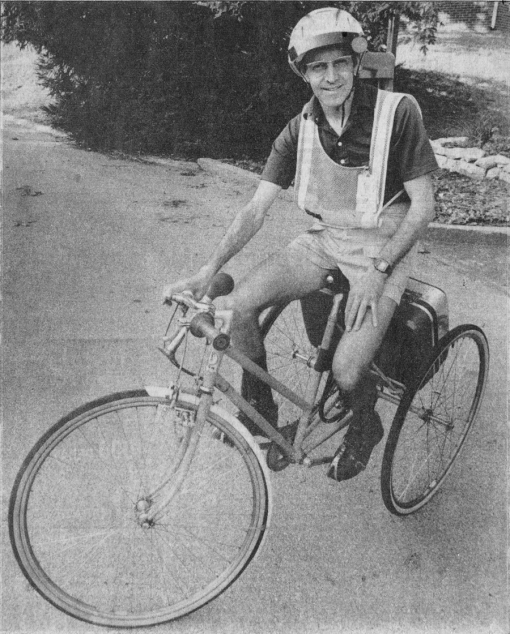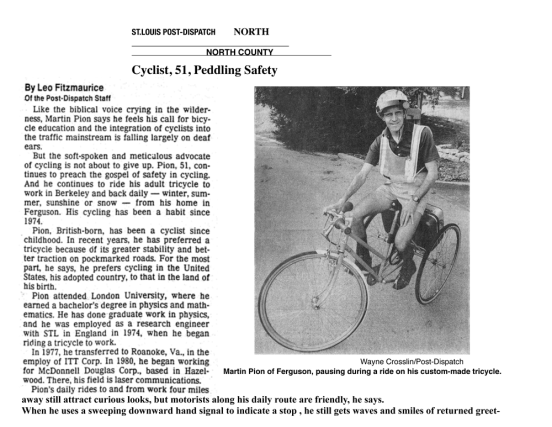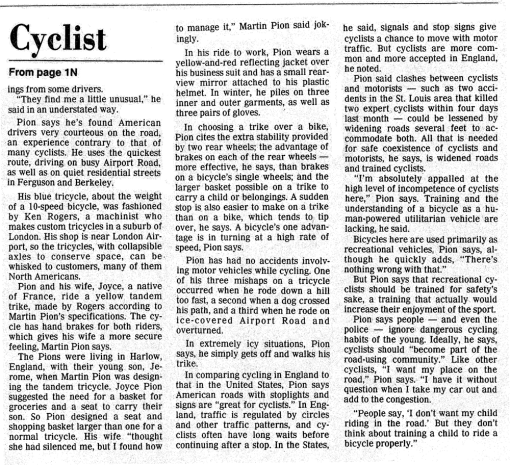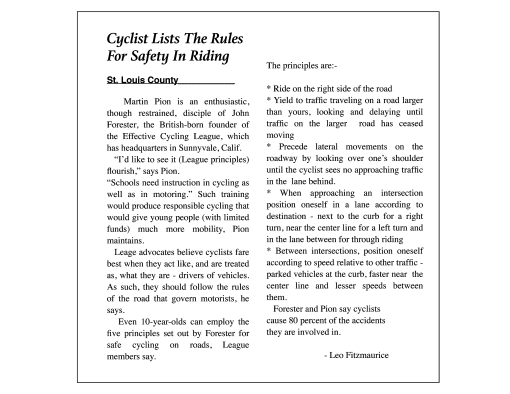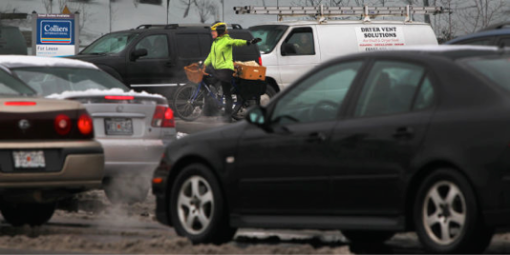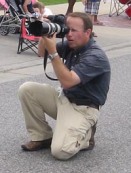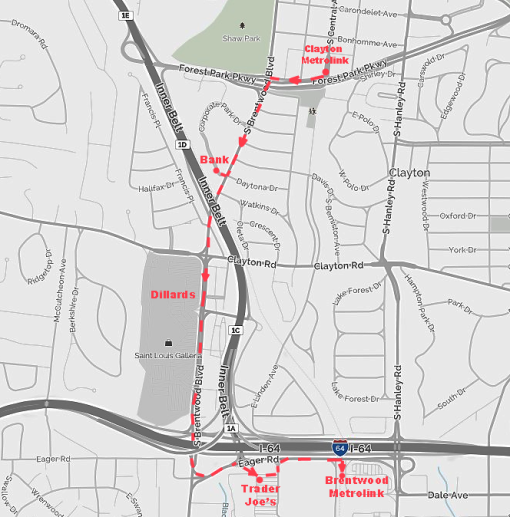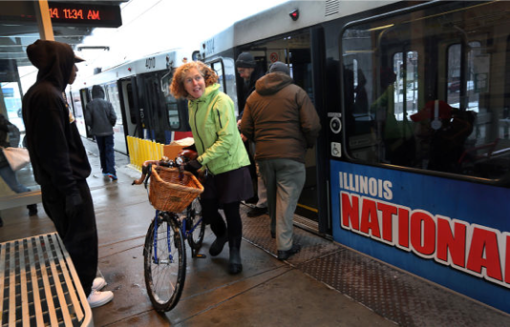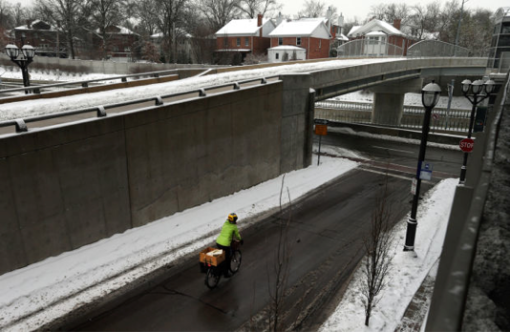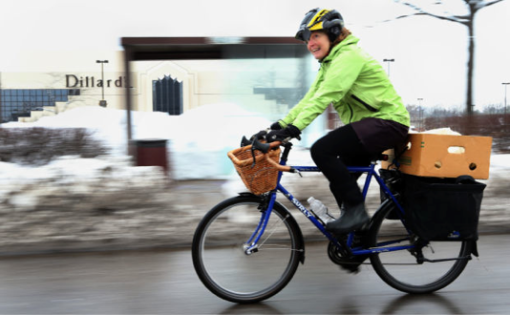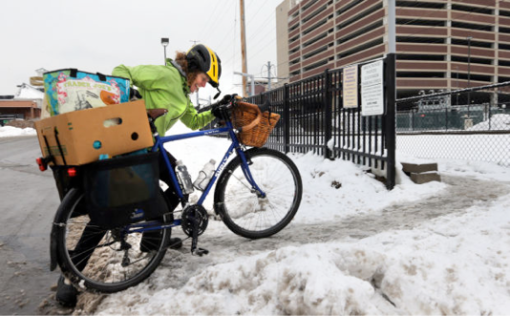This excellent PowerPoint presentation was created and given by Karen Karabell on August 20th, 2015, at 4240 Duncan Ave, St. Louis, MO 63110, part of the Cortex Innovation Center in the Central West End. About 25 people attended and afterwards there was a lively discussion, which isn’t recorded here. A presentation transcript with selected screen captures follows the video recording below.
Description: Karen Karabell is a dedicated, enthusiastic, and motivated CyclingSavvy instructor in St. Louis, Missouri. On August 20th, 2015 she gave this enlightening half hour slide presentation at the Cortex Innovation Community, near her home.
Karen shows how our public roads were not built for cars but for travel, in the early 1900s primarily by horse and bicycle, and only later dominated by motor vehicles.
While her focus is on bicycle transportation, she is not anti-car, arguing that her choice to drive a car or a bike on any given day shouldn’t change how she is viewed by other road users. Nor how she herself prefers to use the road.
“People will choose bicycling when they feel expected and respected as a normal part of traffic,” Karen says.
Karen, and people like her, are already doing so.
A relevant peer-reviewed paper, “Promoting Equality through Bicycling Education in the U.S.,” published in January 2016 in the Institute of Transportation Engineers Journal, can be viewed and/or downloaded here: thinkbicyclingblog.files.wordpress.com/2016/01/promoting-equality-through-bicycling-education.pdf
Note: Most of the presentation slides are the work of gifted graphic designer and experienced cycling educator, Keri Caffrey, of Orlando, Florida. She and Mighk Wilson co-founded CyclingSavvy in 2010, now a key part of the nationwide American Bicycling Education Association, on-line at abea.bike, which became a not-for-profit 501(c)(3) in 2015
Transcript of Karen Karabell’s bike ed PPT presentation on 2015-08-20, with elapsed time noted at intervals below.
Karen Karabell at the lectern, after welcoming the audience, introduces the subject with an opening slide on the screen behind her:
Thank you for being here. My name is Karen Karabell. I’m a traffic cycling educator, which is a new line of work in the 21st century. I’m here in the spirit of this community: How can I help you to travel safely by bicycle should you so choose. And if not, to increase your understanding of the dynamics at play today on our public roadways.
I want to start with the context. Our streets are a public way. Without question, our network of roadways is by far our largest public property. Our roads have been used for centuries not only for travel but for socializing, commerce, and play.
I have a question for you? Has the street changed, or have our beliefs changed? There are still people alive today who remember when motor vehicles were a strictly regulated minority in the interests of public safety. It wasn’t until the 1930s and 1940s, and more so in the ‘50s and ‘60s, that motor vehicles became ubiquitous, pretty much overtaking our public roadways. This is less than 100 years.
I want to talk a bit about the U.S. traffic system. The U.S. traffic system is a marvel of elegance and simplicity. It’s deeply ingrained in all of us. For example: we know to stop on red, go on green. The U.S. traffic system is very safe, not perfect, we have a long way to go to reach Vision Zero: zero fatalities. But the U.S. traffic system is very safe. You know this if you’ve ever lived in what shall remain unnamed a number of other countries on the planet. One thing you observe when you come back here is: driving in the United States is boring! Boring is good, right? Boring is safe, when you’re talking about transportation.
What most people don’t know is that the U.S. traffic system was created before motor vehicles were common. 3:02 min.
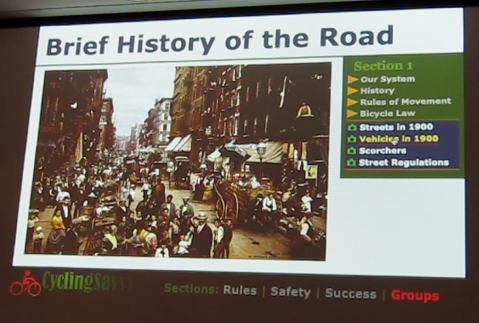
Brief History of the Road
This is what our streets looked like when our traffic system was created.
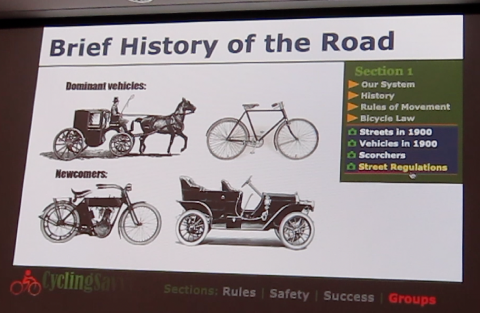
Dominant vehicles & newcomers in 1900
This is what vehicles looked like when our traffic system was created.
Does anybody know what a “scorcher” is?
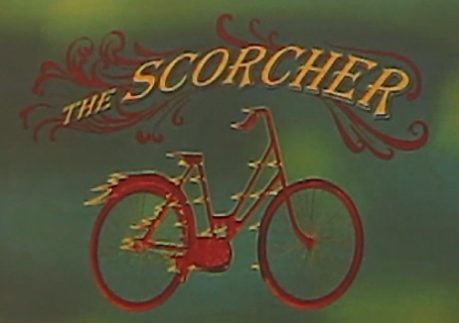
The Scorcher!
Scorchers! They were stereotypically young men who rode their bicycles at breakneck speeds with reckless disregard for everyone else. At the turn of the 20th century scorchers, among others, were causing chaos and a lot of crashes on the roads and it led to a public outcry that somebody needs to do something!
William Phelps Eno was a New York city businessman. The Institute of Transportation Engineers – whose new president, by the way, was just elected [and] is from St. Louis – is an international organization of scientific and educational association of transportation professionals. The Institute of Transportation Engineers made this man its first honorary member. Eno is called the father of traffic safety because he invented pretty much everything that we take for granted today in our public roadways. For example, Eno invented the stop sign, the one-way street, the pedestrian crosswalk, the traffic circle. He created the world’s first traffic plans for the city of New York in 1903. He also created the traffic plans for Paris, Brussels, and many other cities around the planet. He invented drivers licenses, and he invented license plates for automobiles. What is one thing the father of traffic safety never did?
He never drove a car. He never learned how to drive. He died in 1945 [and] never learned how to drive.
People who say that our rules of the road are for cars are just wrong. The rules of the road are not based on speed, they’re not based on size, they are based on another S word. Does anybody know what that is? Safety! Can anyone tell me why we have our rules of the road? The rules of the road are designed to keep a bunch of independent moving parts from crashing into one another.
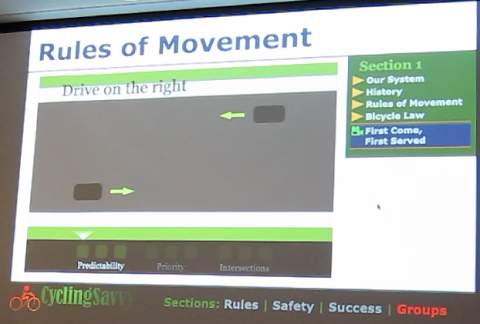
Rules of Movement
Perhaps the most important thing Eno did was apply the rules of movement to our public roadways. He didn’t invent this but he applied these ideas to the roads: drive on the right, pass on the left; use destination positioning; first-come, first-served. We’re gonna talk more about this. Yield before making lateral moves. You yield before entering a road where others have the right-of-way. 6:28 min.
Listen! [Emphasizing with arms.] If this is news to any of you, I am not driving home with you tonight! [Chuckles from audience.]
What does first-come first-served mean? If you’re first you have the right-of-way. Let’s see what this looks like.
[Animated graphic showing bicyclist being passed by motorists who then queue at a stop sign. The bicyclist then passes them on the right until she reaches the intersection.]
I hear some of you laughing. I have a question for you: Who else has the right of way? How about all those motorists who safely passed her, and now she’s going to make them all pass her again?! It is very bad form to make a motorist pass you twice.
[Pointing to her husband, Harold.]
My husband is laughing. [Karen pointing to two in the audience while laughing: “You’re right, you’re wrong.”]
I’m only going to talk for about half an hour then the rest is for Q and A.
My husband pointed out: “You know, bad form is actually the least of her worries,” but we’re not going into the weeds right now. The point is, respect goes both ways, right? Cooperation and courtesy are the hallmarks of the U.S. transportation system.
So I hope that at least one of you by now is saying: This is all well and good. I get it. We are equal on our public roadways. We are most definitely not the same. [Emphasizing with arms.]
No question. Not the same.
Middle-aged woman on bicycle! [Placing both hands on chest below neck to indicate herself.
Gesturing to imaginary person to her left and waving to him.] Cute guy in Hummer!
Yeah, not the same, not the same, that’s for sure!
We have a new way of thinking about cyclist behavior. Before I talk about this I want to make three points:
The first is that the father of traffic safety moved pedestrians out of the street. He moved pedestrians onto sidewalks because pedestrians have different operating characteristics than drivers.
Point number two: Motorists have pretty standard operating characteristics compared to bicyclists. Motorists are big, and motorists are fast.
The third point is that the father of traffic safety defined who a driver is more than 100 years ago. We still use that same definition today in all 50 states. Cyclists are drivers because our operating characteristics are most similar to others who use wheels to get around. But on this behavior spectrum, which is a new way of thinking about cyclist behavior, we are the only ones who can exhibit a variety of behaviors.
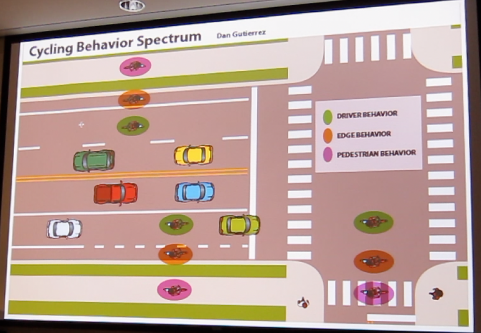
Cycling Behavior Spectrum 10:14 min.
We have what we call driver behavior, which you can see is driving your bicycle in the road like other drivers drive their vehicles. Edge behavior is riding on the edge of the road; we going to talk more about this. Pedestrian behavior is what? In Missouri “Pedestrian behavior” is illegal in business districts; not illegal in other areas.
Pedestrian behavior, riding on the sidewalks, is actually by far the most dangerous kind of behavior because motorists aren’t expecting fast-moving objects piloted by people on sidewalks. 11:00 min.
So I want to talk a little bit more about edge behavior now the you’re familiar with this concept. When you’re out, observe where most cyclists ride. They ride on the edge of the road. I think you’ll notice that’s your observation. On the face of it there are two good reasons for this: one is courtesy – nobody wants to be in the way. The other is fear. Cute hummer dude is texting on his cell phone now and he might not see me. I’m gonna get on the edge of the road!
So, what we discovered, as traffic cycling educators, is that safety as a cyclist is a product of your behavior. And your behavior influences your worldview and the stories that you tell. If you ride on the edge of the road you likely have a number of dumb motorist stories.
Here’s a common one from a cyclist point of view. The cyclist says: “I’m just riding along and this stupid motorist cuts me off and turns right in front of me!” So, think of this from the motorists point of view. The motorist probably says about that cyclist: “She rode up in my blind spot as I was turning right. I couldn’t see her. I almost hit her.” 12:34 min.
When cyclists are hit you often hear what a tragedy it is for the cyclist and his or her family. You know, motorists have to live with this for the rest of their lives too, and motorists don’t want to hit cyclists. So I want to talk to you about the bike lane that gave birth to CyclingSavvy.
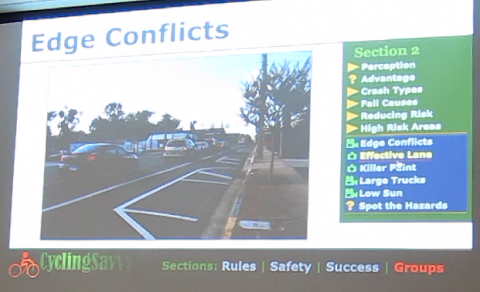
Edge Conflicts 13:00 min.
CyclingSavvy is new. It’s about five years old now. It was founded by two people. One is a transportation planner; the other is a graphic designer – both of them longtime bicycle commuters. This is Edgewater Drive in Orlando. It’s very similar to our town’s Delmar Loop. A highly desirable street: lots of people want to go there for a lot of reasons. The graphic designer put her office on Edgewater Drive in part because of this bike lane. Then she started using it. I want to tell you her story, but first I want to show you a few seconds in the life of Edgewater Drive. [Shows video clip of cars driving down road with a bike lane alongside curbside parking.]
Where is all the action on this road? Turning off; coming on. Well, it’s on the edge of the road. Where’s the bike lane? On the edge of the road.
So, like most cyclists, Keri, the graphic designer, had her share of dumb motorist stories, yet on this stretch of road she found that her negative interactions with motorists increased exponentially. She even got hit by a car once, though it didn’t change her behavior at the time. But as time went on she grew weary of white knuckle bicycling, like OK, who do I have to watch out for now; who’s going to kill me next. 15:23 min.
I mean, she was at the end of her rope, and she loves bicycling. She didn’t want to give it up, but she was frustrated, she didn’t know what to do. She got online and she Googled “What color can I paint this bike lane so these stupid motorists will see me?” And as will often happen when you’re on the Internet you might end up in a place that you don’t expect to be.
She came across a site run by what she describes as a group of “grumpy old men,” who said: “We never have these problems. Here’s what we do.”
What they do is: They take their place in traffic; they don’t violate other people’s right-of-way; they stop at traffic signals; they practice what we now know is called “driver behavior.” And she’s reading it and it sounds scary to her. But, she’s frustrated and she decides she’s going to try it. So she goes out the next day. And then she does it again the next day. And the day after that. And she feels like she has stepped into an alternate universe. All of those motorists who were so stupid have suddenly become really smart!
It was this epiphany that led to the strategies that are the basis of CyclingSavvy. This bike lane can be useful. We show people how to use it safely. It’s not within the scope of this presentation to discuss that, but CyclingSavvy is all about strategies.
For example, we know that motorists don’t want to be behind cyclists: we call it “Must pass bicyclists syndrome.” In St. Louis this is comical. “Must pass bicyclists syndrome.” I’ll be moving along, motorist comes up behind me, goes around me, stops at the red light, I pull up right behind him. But that’s okay: “Must pass bicyclists.” You know, honestly, I don’t want motorists behind me, not for any length of time. I wear a helmet because of the excellent mirror that’s attached to it. It’s really easy to see with this mirror what’s happening behind me. You know, if it’s safe I’ll wave motorists around and they’re so grateful: they’ll always give me a full lane change. 18:01 min.
Another thing we hear from people is: “I’d like to try bicycling but I don’t wanna use …” fill in the scary road of your choice. And this is a real issue. We have tons of preferred routes all bisected by big arterial roads: Kingshighway, Hampton, Hanley, Brentwood, Olive, Page. I mean, you know: Name your road. “I don’t want to ride on that road.” So we teach people how to get intimidating roads all to themselves for the short amount of time they need to connect to their preferred routes. There is nothing scary about empty pavement. That’s me on empty pavement three years ago with longer hair in a suburb of Detroit.
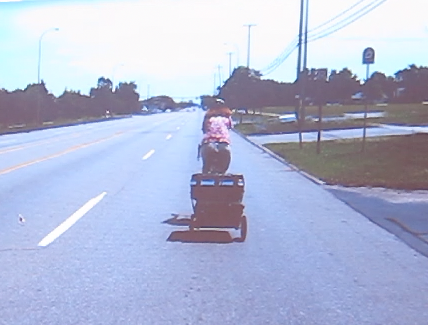
Karen lane-control on empty road 19:00 min.
[Pointing to slide: Cyclist in pink shirt hauling trailer on empty 4-lane plus CTO lane road.]
My husband wanted to go to Detroit that summer to celebrate his birthday by riding his bicycle around the motor city.
[Karen put hands on hips to imply this was an in-your-face intention on his part.; then pointing to slide] I’m towing the suitcases in which we pack our bicycles. By the way, folders fly free on Southwest.
[Positive response of appreciative “Ohs” from audience.]
So we get to the Detroit airport on a Sunday morning and you can’t take public transit downtown on a Sunday: it’s impossible. And we didn’t even really consider a cab because it’s expensive: thirty miles is an expensive ride. And we had all day, so we decided to ride! And when we left the airport we stopped at a gas station, like all good Americans, and we got drinks and a map, and we asked a local how should we go downtown? And the guy said, “Oh, no problem, take Eureka.” That’s sort of like saying to someone who comes to Lambert Airport in St. Louis with their folding bicycle, “I need to go to South County mall. What route should I take?” “Oh no problem, take Lindbergh.”
And really, as it turns out, it was no problem. We had this road to ourselves at least half the time we were on it. The motorists who encountered us on these emptier stretches saw us from so far away they didn’t even take their feet off the gas to change lanes to pass. But we weren’t using Eureka to connect to a quiet route of which we had no knowledge. We were going all the way downtown. And if you’re on the road like this for any period of time you will encounter traffic, especially in an area where a lot of people want to be. Think Lindbergh and Lemay South County mall. And actually we were in Taylor, Michigan, a suburb and there’s this big shopping mall at this intersection. And we’re in traffic with everyone else, and somebody honks at us, and another person curses at us. And we never escalate: we always wave back with all five fingers. You want them to keep their bad karma all to themselves. As it turned out, in this shopping mall we had a place we wanted to go too. So we pulled into the parking lot and a police officer pulls in right behind us.
Slide: Stopped police car & Karen standing alongside [please see below]
They’ve called the police on us! I think she said: “I received two calls saying you are impeding traffic.” I said: “Officer, we are traffic.” And she said: “Well, they were afraid they’re going to hurt you.”
I’ve been riding my bicycle for decades. I promise you I know when somebody is using his or her weapon as a terrorist device. I mean, never once did my husband and I feel like we were in any danger. You know, we’re just in traffic like everyone else. All it was is bigotry. You know, it’s prejudice against bicyclists on the road. It’s like: “How dare you ride your bicycle on this road!” I would like to propose a 21st Century response when people call 911 on bicyclists who are using the road. 23:00 min.
[Karen, pretending to be police dispatcher speaking into telephone to motorist.]
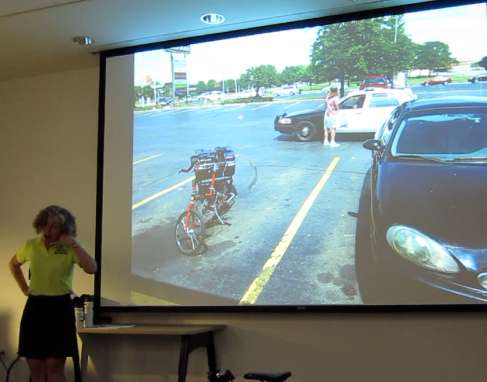
“Please hang up and DRIVE” 23:37 min.
Police Dispatcher: “911. What’s your emergency?”
Motorist: “Officer, there’s a bicyclist on the road!”
PD: “A bicyclist on the road ma’am. Is the bicyclist riding on the road?”
M: “Yes!”
PD: “Oh, that’s good. Ma’am, do you not know how to change lanes to pass?”
M: “Excuse me!”
PD: “Ma’am, do you not know that bicyclists are the reason we have paved roads in America?”
M: “What…”
PD: “Ma’am, will you please hang up your cell phone and drive?!”
[Chuckles from audience.]
So, the officer was very kind. She knew we were tourists; she didn’t want to alienate us. She said “You can’t use Eureka. Go over and use this big road that doesn’t have a shopping center on it; you’ll be fine.” And she was right. Not only were we fine, we had the time of our lives. I promise, you will never enjoy a city as you can from the seat of your bicycle.
My husband likes to take lots of photos and we took our time stopping all along the way. But the day was wearing on and I wanted to get to the hotel and soak in a bathtub. So I’m nagging: let’s go, let’s go! But I had to stop and take this photo. We were crossing a pedestrian overpass and I said “Gotta stop!” [Photo shows very congested road below.]
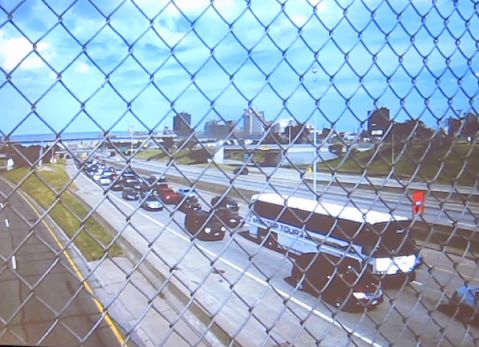
Traffic on Michigan 10 24:33 mins.
I took this photo because I wondered: Did any of those people call the police on their fellow road users?!
[Chuckles from audience.]
Sunday afternoon on the Michigan 10 in Detroit.
I want to finish this presentation by answering the three questions that comprise the description of it.
The first question is: How do we turn the perceived disadvantages of bicycling on the road into strengths?
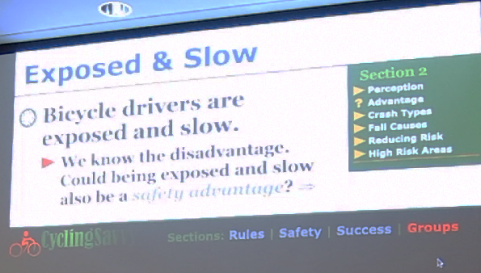
Exposed & Slow
The disadvantages are that we’re slow. I promise you that even Lance Armstrong is slower than every motorist out there. We’re exposed. We don’t have steel around us. We don’t have air bags. But I want to ask you, can you think of what might be the advantages of being exposed and slow?
[Waving arms and inviting audience to respond.]
Come on. Tell me the advantages.
(Incomprehensible: “.. you can stop sooner.” (sic))
“You’re less of a threat to others than you are in a car.”
“You’re providing a good example for the children that are inside the car that are looking at the bicyclists.”
Eli Karabell: “Severe awareness of your surroundings.”
26:23 min. [Eli continued for about 40 secs. until Karen intervened at 27:12 min.]
So the point you made and elaborated on: My son was coming home late at night that night, but no matter how tired you are you’re alert when you’re on your bicycle. You’re not going to fall asleep riding your bicycle, so you’re alert.
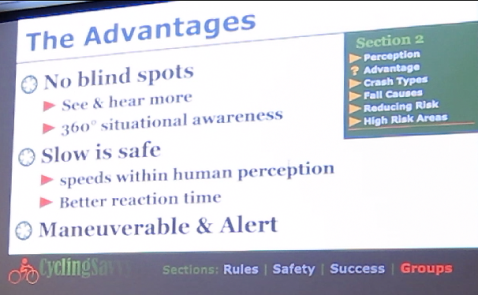
The Advantages 26:23 min.
Let’s see what else there is: No blind spots. You know, motorists have blind spots. Bicyclists have 360° situational awareness. Can stop quicker; better reaction time. The one thing that’s not on this list is that motorists tend to operate conscientiously around us when were on the road. It’s simply our job to be visible and predictable, so that we’re easy to see.
We also, in CyclingSavvy, help people understand what causes crashes so they can avoid them.
And before I show you this I want to ask. A show of hands please: how many of you have been in a crash on your bicycle all by yourself, nobody else was involved, and your bike went “Oops!”
Slide: Common Crash Types 27:29 mins.
[Missed roughly a minute during battery exchange.]
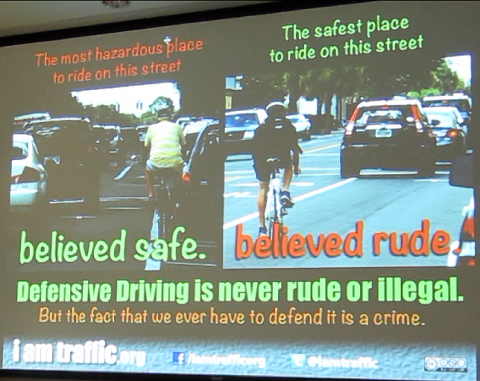
Comparing believed safe vs believed rude 27:43 mins.
This is why we teach safe traffic cycling. What? What is it? News flash: It is not necessary to punish motorists to encourage bicycling.
Can bicycling become an everyday alternative to motoring?
So, the 21st century transportation revolution is well underway. I don’t know whether it includes bicycling or not. If you are transportation professional there is so much happening, your head is spinning on some days. For example: driverless cars. What will Uber and its cohorts mean for transportation? Transit apps. A real-time transit info. on my smart phone has already changed my life. All kinds of things going on. Still, in this country it is so easy to be a motorist in most parts of the nation and it is not cost-prohibitive. So your crystal ball is as good as mine.
I know two things:
Only bicycling offers the freedom of mobility to individual destinations in the way that motoring does, from point A to point B. Bicycling might be superior because I don’t have to find a parking place for my ride.
[Pointing to bike folded up neatly on the floor.]
The other thing I know is this. If we want bicycling to become normal we will no longer have bicyclists. I don’t go into my garage on any given day and [while pointing first right and then left] look at my car, and look at my bike and say: Gee, will I be normal today and use my car? Or will I be a bicyclist?
[Gesturing to herself with both hands]
I am not an “ist.” I’m a human being trying to go somewhere like everyone else. I know how to be a first-class citizen, whether I’m using my bicycle or my car. But because I know this, I choose the vehicle that best serves that day’s transportation needs, and more often than not it’s my bicycle, because I don’t need my two ton land missile to go most of the places that I go. 30:23 min.
[Slide changes from Karen with trailer to i am traffic with mother and child giving R turn signals while controlling the curb lane.]
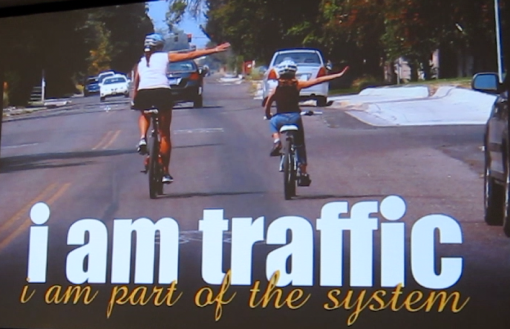
i am traffic slide
So, in CyclingSavvy we solicit feedback from our participants. We send out a survey when they register before they’ve taken CyclingSavvy. After they’ve been through a workshop we send them another survey. We want feedback to hear about their experiences; to improve what we do.
We hear two things consistently from almost every student: the first thing is, CyclingSavvy has made me a better motorist. And the second thing we hear is: I’m more likely to use my bicycle instead of my car! [Karen throws both arms up in the air in triumph.]
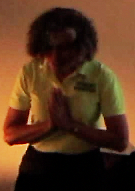
Karen Karabell
People will choose bicycling when they know where the dangers are and are not. When they are encouraged to acquire the knowledge and skill to operate safely no matter where they choose to ride. People will choose bicycling when they feel expected and respected as a normal part of traffic. Thank you!
[Accompanied by a little bow, with hands together like a supplicant, followed by audience clapping.] 31:45 min.BR>
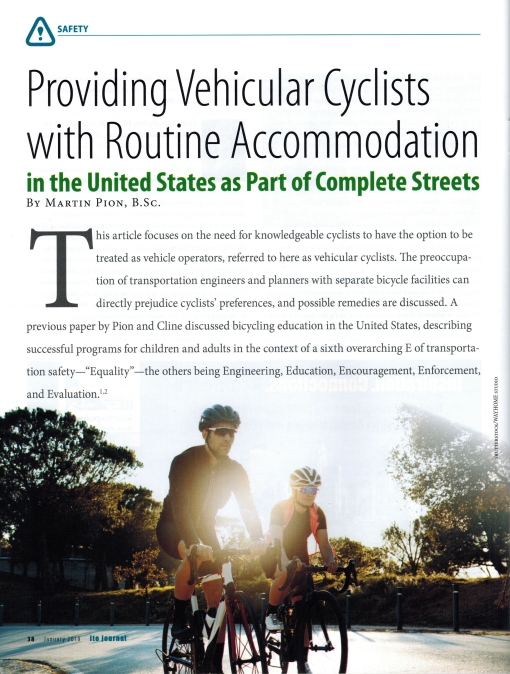
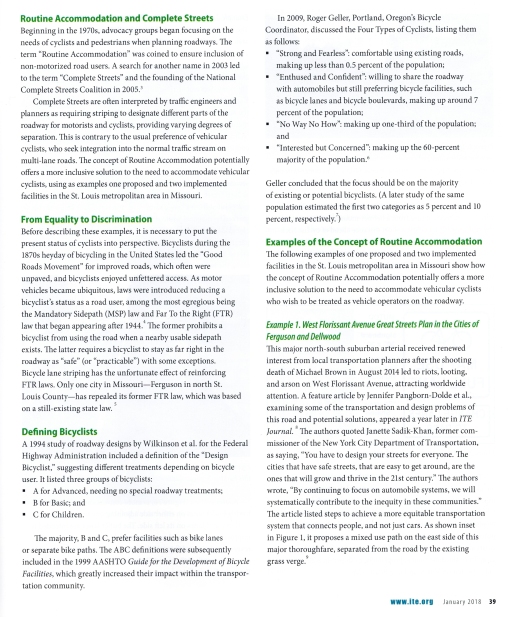
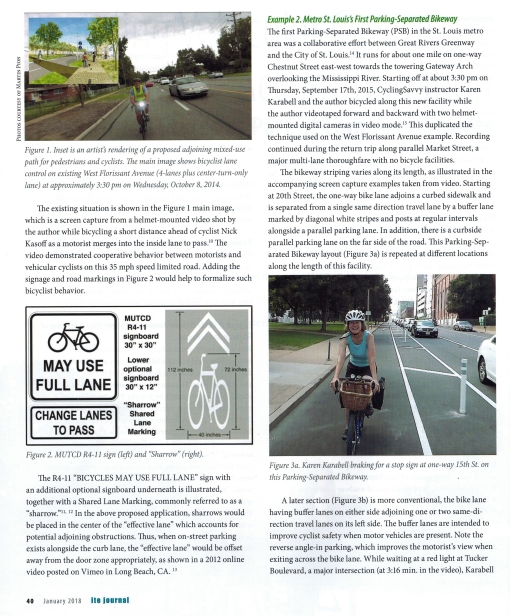
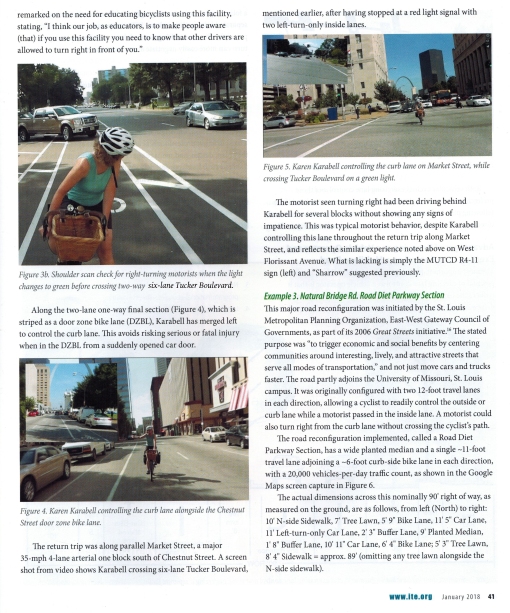
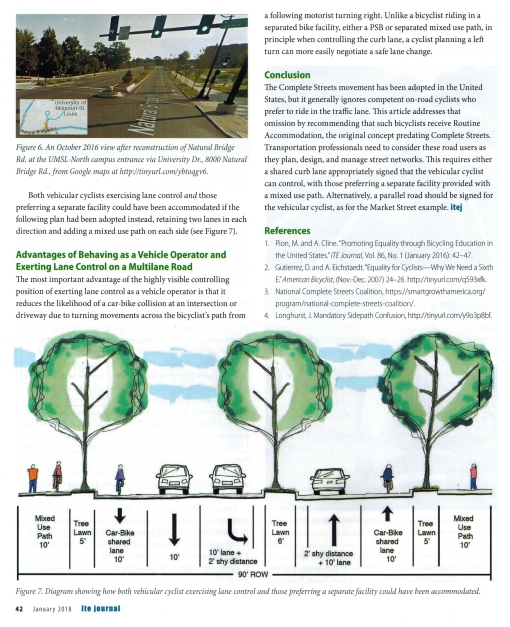
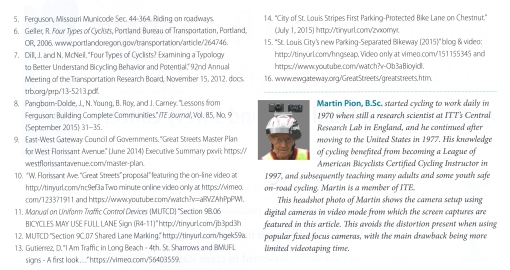
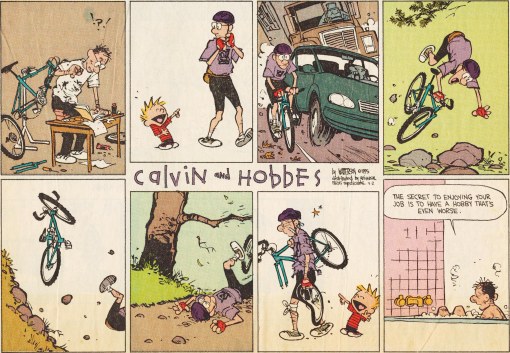
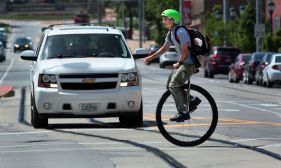
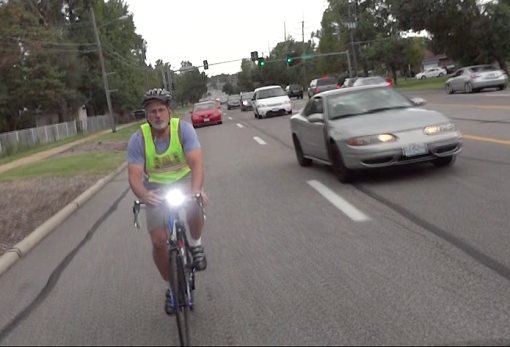
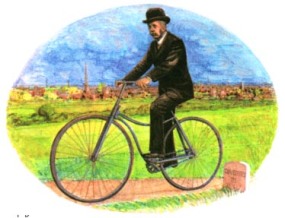

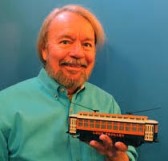
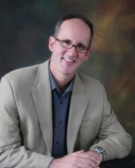
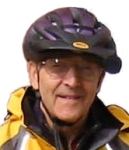
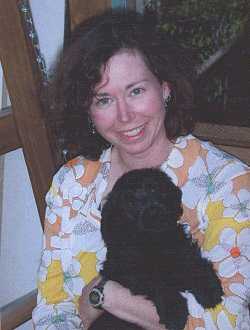
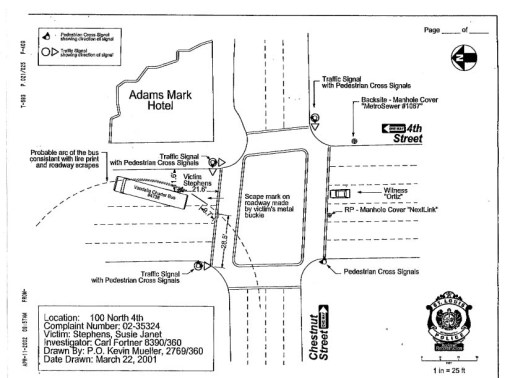 Police report drawing
Police report drawing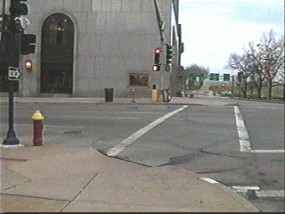
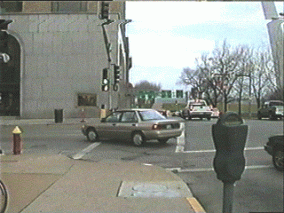
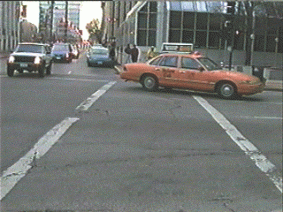
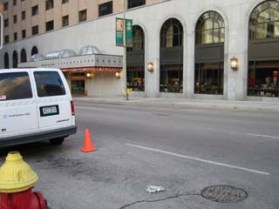
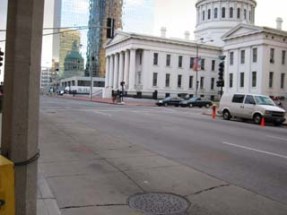
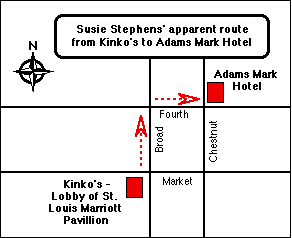














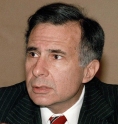
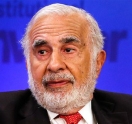
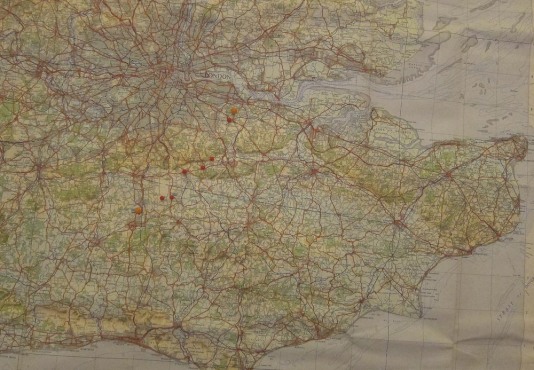
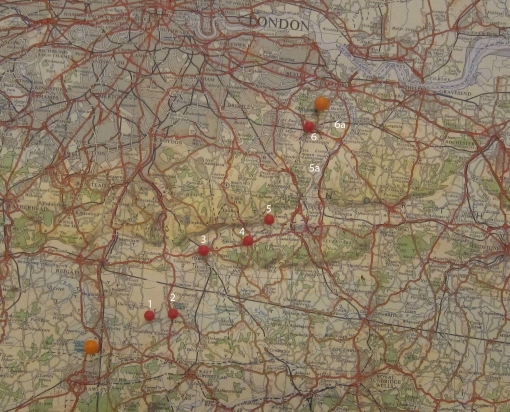
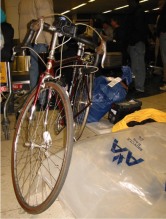
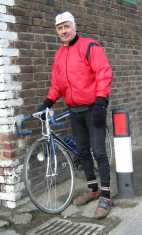
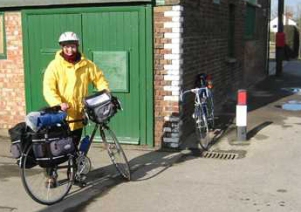
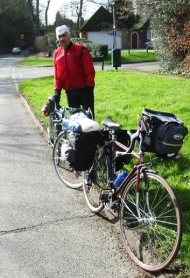
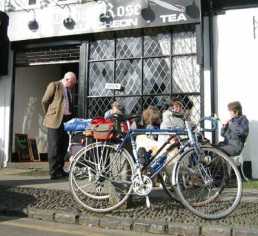
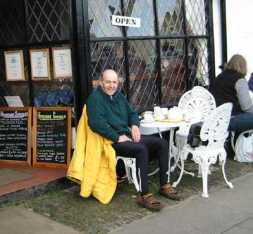
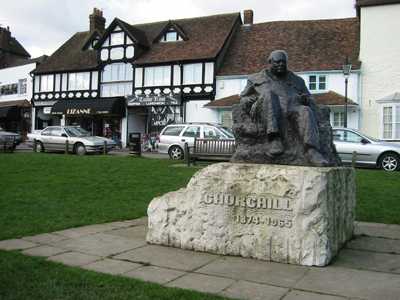
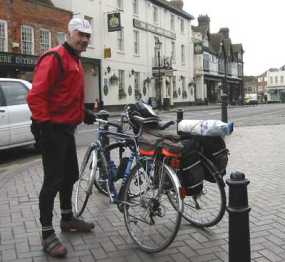
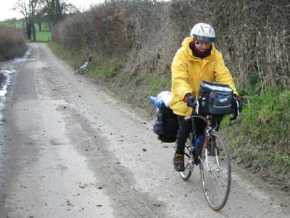
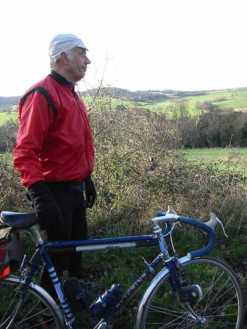
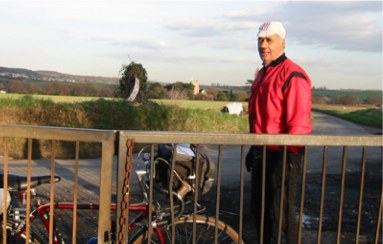
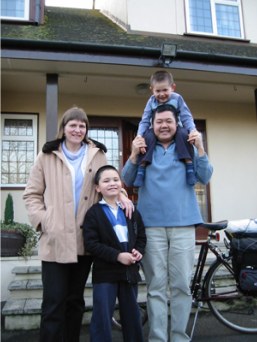
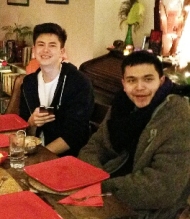
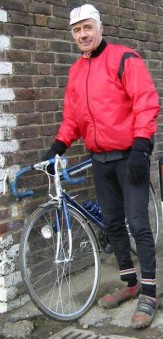
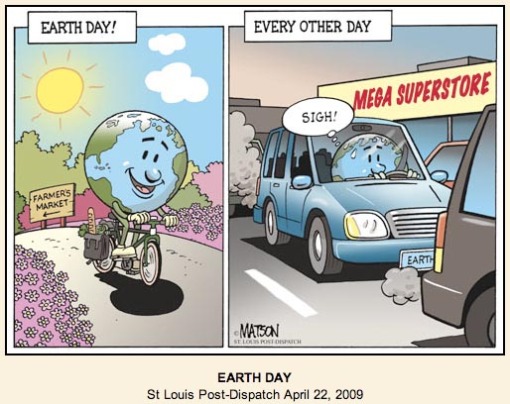
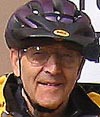 by Martin Pion
by Martin Pion

